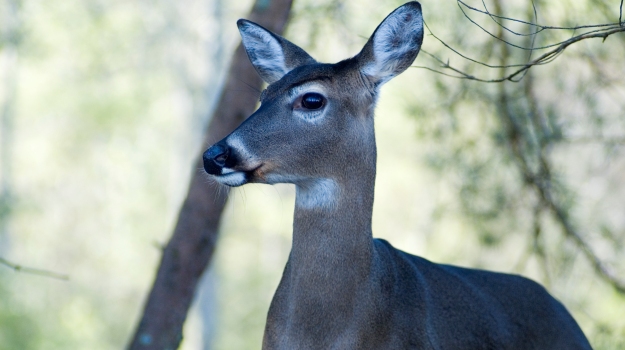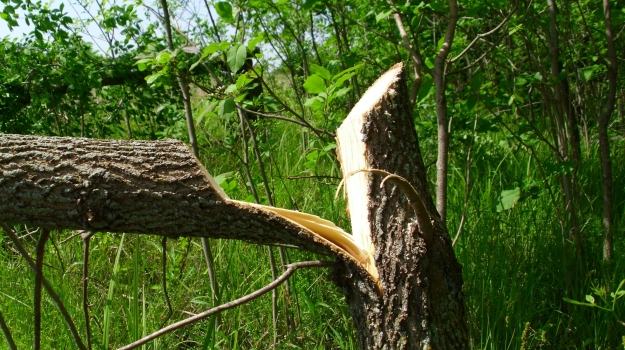
Create food, cover and better hunting
By Brian Beauchamp
Hinge cutting is an easy to do habitat modification that has been gaining popularity over recent years because of the increase in the micromanagement of land to hold more wildlife, improve the hunting experience and increase the odds for hunting success. Most hinge cutting techniques involve cutting partially through a tree and laying it to the ground to create a living, horizontal habitat structure. This technique may be modified and placed appropriately to produce different results.
Hinging can be used to enhance bedding areas through establishment of screening cover, to block deer from using certain locations and trails or to funnel deer towards a stand site. The cut trees may produce stump sprouts and the tops will be within reach of the deer, increasing browse. Edges can be “softened” by utilizing hinge cuts in an edge feathering project to benefit multiple wildlife species. Young trees may also be protected from deer browsing and antler rubbing by establishing a physical barrier. It may also provide a visual barrier to sensitive areas of your property. All in all, its uses are limited only by creativity. Here, we explore a few of these standard strategies.
Before You Cut
When beginning management in a forest setting it is best to obtain the advice from several reliable resources to avoid errors. A forester can give you opinions on forest management and what direction is best to achieve the forest reaction you desire. A wildlife biologist can give advice on habitat structure beneficial to your deer or other species and provide invaluable direction on managing your wildlife populations. Most states have foresters and biologists on staff for consultation. There are also many private consultants specializing in land and wildlife management you can hire for a fee to assist you, many of which provide services that public assistance usually cannot provide.
Another excellent set of resources are the “forums” on the Quality Deer Management Association’s website, www.qdma.com, or the GameKeepers website www.farmingforwildlife.com. Both sites have people from the beginner, who will ask common questions, to professional consultants providing free advice on a variety of subjects. You can find answers to your questions about specific plant identifications, food plots, native habitat management and wildlife management for just about any species of wildlife. Advice on strategies and examples of hinge-cutting techniques abound there as well.
Once you have gathered quality advice and information, decide the best route to reach your objectives by assembling a plan. Planning helps you avoid errors and maximize the effective sequencing of projects. The best plans are adjustable as conditions change and additional information is gathered. In other words, you’ll want “working plans” that will become what they need through monitoring and analysis.
Safe Cutting
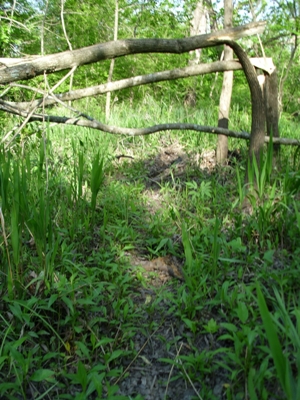 Although hinging is mostly performed on smaller trees, these can still be a hazard if not respected. Sharp stobs are common with proper hinge cuts and one slip-up can prove to be very dangerous. Leaning trees onto or against trees you are going to cut may result in a tree that is “loaded” with energy waiting to be released. Cutting these trees can produce an unpredictable situation. When working on a slope, starting at the lowest point and working your way uphill and felling the hinge cut trees downhill will minimize obstacles. Thinking several cuts ahead and where each tree should land keeps your project moving safely.
Although hinging is mostly performed on smaller trees, these can still be a hazard if not respected. Sharp stobs are common with proper hinge cuts and one slip-up can prove to be very dangerous. Leaning trees onto or against trees you are going to cut may result in a tree that is “loaded” with energy waiting to be released. Cutting these trees can produce an unpredictable situation. When working on a slope, starting at the lowest point and working your way uphill and felling the hinge cut trees downhill will minimize obstacles. Thinking several cuts ahead and where each tree should land keeps your project moving safely.
An extra set of eyes can spot dangers above and around you while you are focused on cutting, so avoid cutting alone. Bigger trees nearby may have large dead limbs ready to come crashing to the ground from a slight brush from a tree you are hinging. Your spotter can help keep you safe and can get assistance should there be an accident.
Functional tools and protective equipment are essential to safety. A lightweight chainsaw with a sharp chain will produce quick cuts and a lower rate of fatigue. A solid, sharp bowsaw could be an appropriate choice for smaller trees and inexperienced chainsaw users. For everyone though, gloves, goggles/safety glasses, chaps when using a chainsaw and a hardhat are crucial. Many may skimp on these items, but one split second could prove their worth should an accident occur.
Cutting Technique
A consistent hinge requires a different technique than what you may think. This modified cutting technique simply attempts a downward cut at a 45-degree angle. This angle is a little more difficult to start, but consistently produces better results. A good hinge usually cuts around two-thirds to three-quarters of the way through the tree between knee and waist height, cutting just enough holding wood to allow you to push the tree to the ground. Depending upon the tree species, the more of the tree you leave intact, the more growth you’ll get from the felled tree.
When hinging larger trees, an assistant adding pressure in the desired falling direction increases ease of implementation. Pulling a rope attached securely above where you are cutting creates leverage when pulled to prevent saw blade pinching, improves directional felling, and keeps your helper safely out of the chainsaw’s proximity.
Selecting Trees to Hinge Cut
When starting your hinge cuts, be sure to choose the most appropriate trees to hinge. Selecting the right species to hinge is important for the long-term health of your forest as well. Proper choices up front will help reduce the amount of inputs and work over time. Optimal sizes for hinging are usually around six inches or less in diameter. Trees that would be tough to split for firewood such as elm can be hinged at the larger end of the diameter spectrum. Also, trees lose their flexibility in colder temperatures and are more likely to break off during hinging, top-killing the tree. Typically, hinge cutting conditions are good when the weather is warm and the tree fluids are active.
Individual trees selected should meet overall planning objectives. Before starting, you should have a good idea about what trees are best to hinge, what trees to protect and what trees to kill as a part of Timber Stand Improvement (TSI).
Species ideal for hinging will produce valuable browse or will create structure persisting longer than other species. Palatability and browse preference varies between regions and some trees lose value to deer as they grow out of browsing range. Utilizing a consultant to mark trees to protect, hinge or remove as a part of an overall management plan can help to efficiently reach your goals.
Basic Hinge Cutting Strategies
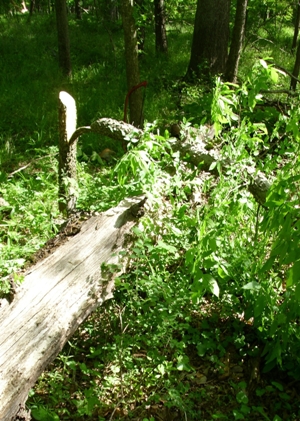 Strategies for utilizing hinge cuts are many. There are techniques to improve bedding areas, restrict movement, encourage movement, increase browse, edge feather, improve timber, create visual barriers, and protect trees. Using creativity, modifying and combining these strategies can reap the most benefit for your wildlife. Following are individual guidelines to utilize.
Strategies for utilizing hinge cuts are many. There are techniques to improve bedding areas, restrict movement, encourage movement, increase browse, edge feather, improve timber, create visual barriers, and protect trees. Using creativity, modifying and combining these strategies can reap the most benefit for your wildlife. Following are individual guidelines to utilize.
Timber Stand Improvement
In most instances, hinging can also be considered a form of TSI. Although many hinge cuts can live for years, most may die within a couple years depending on many factors. Herbicide application along with the implementation of this technique can be useful to further control undesirable species with the benefit of horizontal structure created on the forest floor. Hinge cutting may also be used to release individual trees from competition for resources.
Bedding Areas
Individual beds can be established in select locations that allow a deer to see through hinged trees downwind while having cover at their back where they can detect danger by scent. Trees that have fallen naturally or have been felled for TSI are a good starting point for these single beds. Leaning hinged trees across these logs can create an optimal bedding location.
Larger bedding areas require less “rhyme or reason.” Hinging many trees in a location that will reduce overall visibility, but does not significantly restrict deer movement is the most desirable. Create good cover but allow for a quick escape when necessary. A hinge cut or group of hinges every 30 to 100 feet is a good rule-of-thumb to follow for these areas.
Bedding area location can be crucial to minimizing deer disturbance. Building these areas where disturbance is unlikely will maximize the effectiveness of their deer-holding capabilities. Planning your stand locations in conjunction with these areas will increase your likelihood for success. Place stands where your scent will not blow into them and accessing the location will not alert deer to your position. You may also treat the new bedding locations as sanctuary where they are only disrupted if necessary.
Browse
Creating browse areas with hinge cutting is very similar to establishing a larger bedding area. However, there are some key differences: the frequency of hinge cutting is higher and some trees may need to be removed from the canopy in order to let more sunlight reach the ground. The most beneficial area selection for use as a browse-production area, depending on your overall objectives, is one that has low utility to deer like a mature stand of timber and does not have a legitimate potential for timber value in the future. You can divide a large area up into units or choose several locations throughout a property to periodically hinge or clear cut to consistently maintain part of your property in usable browse. Doing so also spreads the work over years rather than having one large project every three to five years. Instead, one or a set of the management units may be cut every one to three years depending on tree growth rates. The hinging and browse cut management units should be organized so that areas next to, or close to, one another are not cut in sequence.
Funneling and Blocking
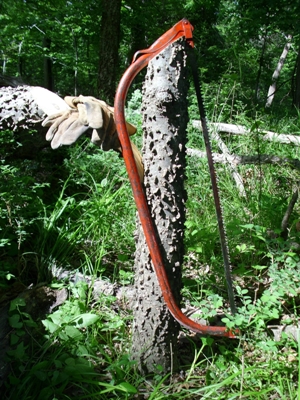 Hinge cuts can also be utilized to funnel some types of wildlife into a specific area. Influencing deer in this way requires an almost impenetrable series of cuts layered on top of one another. This is a lot of work, but can be very effective when deer do not have other features concentrating movement. This is an excellent way to put deer into range of a stand site or for trail-camera monitoring.
Hinge cuts can also be utilized to funnel some types of wildlife into a specific area. Influencing deer in this way requires an almost impenetrable series of cuts layered on top of one another. This is a lot of work, but can be very effective when deer do not have other features concentrating movement. This is an excellent way to put deer into range of a stand site or for trail-camera monitoring.
Oftentimes, deer will wind up in the wrong spot while hunting. They will pass through an area where they detect your scent or that makes effective shot placement impossible. Blocking off a path so they cannot use it anymore with a few well-placed hinge cuts can be helpful in eliminating this kind of situation. Funneling and blocking used together can place deer right on your “doorstep.”
Edge Feathering
Edge feathering is a management technique that benefits many wildlife species. For deer specifically, it creates a more gradual transition between ecotypes providing additional browse and cover. Deer enjoy the safety it provides when established next to an open field or a food plot and will use it as a staging area before exiting cover. This technique creates a wider transition area between an opening and wooded area by removing canopy levels away from the field edge. Hinging selected mid-story and overstory trees to create this effect not only provides browse for deer, but improved brooding and screening cover for gallinaceous birds such as quail.
Protecting Seedlings and Saplings
Protecting natural regeneration or tree plantings can be an effective use of hinge cutting, too. Hinging trees and planting seedlings into the tops for a physical barrier inhibiting browsing and rubbing can increase survival significantly. Applying herbicide as a basal or hack-and-squirt treatment to the hinged or undesirable trees can help reduce competition for your new seedlings as well. Natural regeneration can be protected through identification of vulnerable trees and simply hinging trees around them.
Visual Barriers and Screening
For some landowners, poaching and deer disturbance from roadways and neighbors can be a significant hindrance to management on their property. Simply accessing their property without disturbing deer can be a problem, too, when deer insist on bedding or otherwise utilizing parts of the property that put them in consistent contact with these access roads and gates. Utilizing hinge cuts in select spots can reduce visibility into the property from roadways and of property access trails by deer occupying nearby areas.
Greater Benefits
Although these guidelines are heavily biased toward helping deer and deer hunting, they do not only benefit deer. Implementation of these hinge cutting guidelines will improve food and cover for a number of different wildlife species. Rabbits will enjoy the new, living brush piles as screening and escape cover. Quail habitat will be greatly enhanced through edge feathering, bedding location modification and browsing area release. Habitat should react in a positive way to provide better broadleaf ground cover for nesting turkeys. Squirrels and other wildlife will take advantage of increased mast production. The benefits to other wildlife species go on and on.
When multiple strategies of hinge cutting are implemented together, the effectiveness increases significantly. With implementing any new management technique on your own, however, it will take some trial-and-error to find what works best for you and each particular situation, even with planning. Utilizing all resources and good advice from those that have performed the work before, you can begin to maximize the effectiveness of what you implement right off the bat. Before you know it, you will be holding more wildlife, increasing browse, moving deer away from where you do not want them, closer to where you do, and creating a better outdoor experience.
















